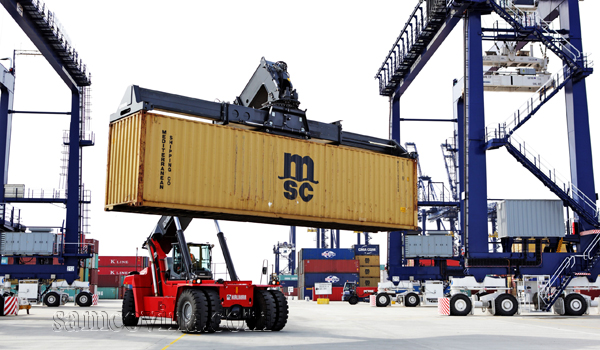Forklift stability and maneuverability
In this article, Samcovina.com will go into depth, specifically about the stability and maneuverability of forklifts.
What is stability?
When working with loads, forklift stability is one of the most important aspects that forklift users need to be aware of. Here are a few features you should keep in mind.
Load capacity (Load capacity/load capacity)
The maximum weight (material, cargo, object) that a forklift can carry at a “load center” is given, vertical masts (the vertical columns in front of the vehicle allow the load to be increased and decreased as well). such as lifting support) is placed in a vertical position. Load ratings are usually expressed in kilograms or pounds and standard load centers are expressed in mm or inches.

Download Center:
Load center describes the distance from the surface of the branches to the center of gravity of the load. The center of gravity of any loaded object is the imaginary point about which the object’s weight is evenly distributed. Forklifts do not have a fixed center of gravity, the center of gravity moves as the machine performs a number of tasks such as:
Lift or place a load.
As a load is raised and lowered, the coordination center of gravity will also move up and down.
As the mast is moved forward and back, the coordination center of gravity also moves forward and backward.
As the mast tilts forward and back, the coordinating center of gravity will also move forward and backward.
Triangle stability:
All forklifts regardless of size, weight or wheel count have a ‘stability triangle’. Triangular stability is the area under the forklift where it must hold the center of gravity in the truck in order to be stable. If the center of gravity moves outside the stable triangle, the forklift will topple or the load will fall.
Maneuverability:
Maneuverability is an extremely important topic to be ensured and understood when researching and learning about forklifts as it is often overlooked until it is too late.
Mobility: A very important feature that determines the working efficiency of the forklift, including parameters such as: maximum travel speed, speed of movement on different terrain surfaces, the ability to overcome obstacles. , ability to climb slopes, maximum lift range, farthest distance, boom/body rotation speed, or ability to work in harsh environments.
Maneuverability is generally the ability of a forklift to move flexibly during operation.

Tilt angle:
Tilt angles are the maximum angles at which a mast can be tilted forward and backward. Different angles of inclination in different forklifts, masts and attachment loads are also limited to the mast to maintain truck stability. It is useful to know that depending on what material/cargo you are working on, you may require a higher tilt angle to ensure stable maneuverability and avoid any loss of load. .
Stack the goods and turn to the right corner:
Right Angle Stacking Aisle (Right Angle Stacking Aisle) is the term to describe how much load a forklift can carry and turn to a 90 degree angle. When you come into contact with the shelf and load the material/goods onto the shelf this is the most important piece of information you need to know, as it will tell you the maximum load you can carry.
Slope:
The corners of a road/slope, the forklift can still move up/down. The slope is the key factor to take into consideration as to whether the forklift is being carried or not.
Xe nâng cũ, xe nâng điện, xe nâng hàng







